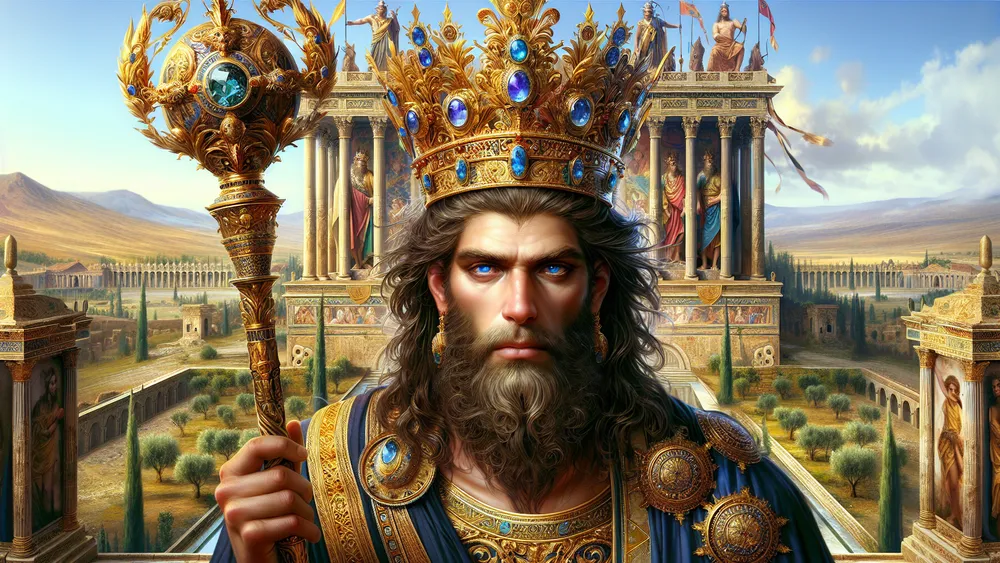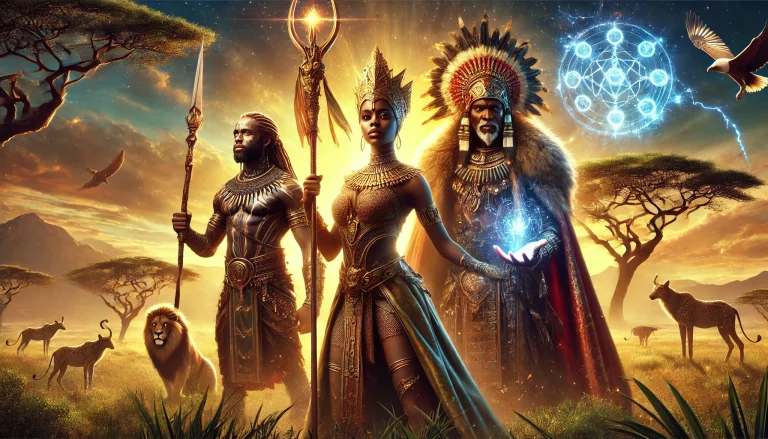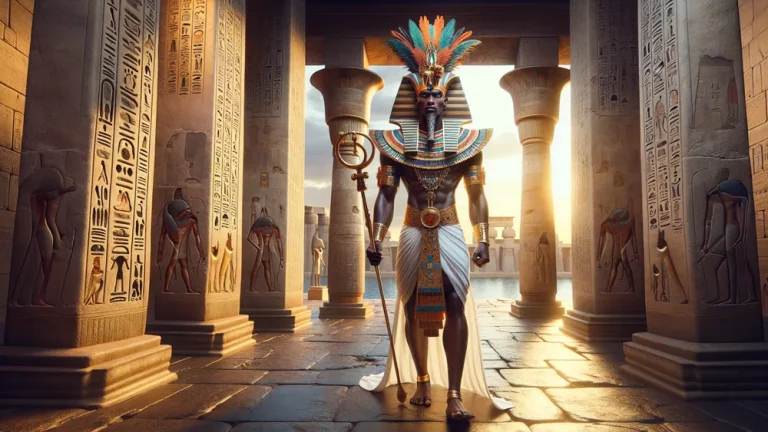Minos: The Mythical King Of Crete And His Legendary Reign
When you think of legendary rulers in stories, King Minos of Crete often stands out as a very powerful and influential person. Imagine a leader who not only gains respect but also shapes laws and the culture of his land. This was Minos. In this blog post, we will look at the interesting life and reign of Minos, seeing his mythological origins, his rise to power, and his lasting legacy.
Key Points:
- King Minos, born from the god Zeus and princess Europa, became a mighty ruler of Crete.
- Minos built the Palace of Knossos, a grand symbol of his power and cultural prosperity.
- His relationship with gods, especially Zeus and Poseidon, played a crucial part in his rule.
- Minos broke a promise to Poseidon, leading to the birth of the Minotaur, a creature with a man’s body and a bull’s head.
- To contain the Minotaur, Minos had Daedealus construct the Labyrinth, a complex maze nearly impossible to escape from.
- After the death of his son, Minos demanded a tribute from Athens, which led to the famous story of Theseus and the Minotaur.
- Minos’ legacy expands past his life; he is remembered as a judge in the Underworld and frequently appears in various forms of art, literature and popular culture.
Due to his divine parentage, Minos being the son of Zeus and Europa, he made laws and the big Palace of Knossos was built. Minos’ story is one about big and complicated things. We will also look at the dark parts of his reign, such as the story of the Minotaur and the intricate maze built by Daedalus. There is also the tribute they demanded from Athens.
Lastly, we will see how Minos’ legacy goes beyond his life, like his role as a judge in the Underworld and how he appears in many books and works. Join us in this talk about the life of Minos, the mythical king of Crete, and find out about the different layers of his legendary reign.
Minos: Overview and Key Facts
| Key Point | Description |
|---|---|
| Parentage | Minos was the son of Zeus, the king of gods, and Europa, a Phoenician princess. |
| Birthplace | Born on the island of Crete, which became the center of his rule. |
| Siblings | Two brothers Minos had. Rhadamanthys and Sarpedon, playing big parts in Greek stories. |
| Rise to Power | Minos got to be king of Crete facing many problems, like disputes with his brothers. |
| Laws and Order | Known for creating laws and keeping things in order, Minos was seen as a fair and just ruler. |
| Palace of Knossos | Minos ordered building the Palace of Knossos, a big cultural landmark. |
| Divine Relationships | Minos had strong ties with the gods, especially Zeus and Poseidon, which shaped his rule. |
| Minotaur Myth | Central to the myth of the Minotaur, a creature from a curse by Poseidon involving Minos’ wife, Pasiphae. |
| Labyrinth | The maze, which Daedalus designed, was built to hold the Minotaur and is a main part of Minos’ story. |
| Tribute from Athens | Athens had to send tributes to Crete due to Minos’ power, leading to the well-known story of Theseus and the Minotaur. |
| Legacy | Minos’ legacy means his role as a judge in the Underworld, showing his fairness. |
| Cultural Depictions | Shown in many forms of art, books, and popular culture over time. |
The Beginnings of Minos
To understand the famous rule of Minos, we need to check out how he started and what early things shaped his life. Let’s look into the legend of Minos’ beginnings, beginning with where he was born and his family.
Minos’ Birth and Family
Think about being born where your dad is the boss of the gods and your mom is a really beautiful princess. This was the situation for Minos, with Zeus as his dad, the boss of Mount Olympus, and Europa, a princess from Phoenicia, as his mom.
According to Greek stories, Zeus loved Europa and he turned into a big bull, carrying her across the sea to Crete. There, Europa had three sons: Minos, Rhadamanthys, and Sarpedon. Minos’ birth was important not only because of his godly parents but also because it set the stage for his future as a powerful and influential king.
His family ties connected him directly to the gods, giving him a sense of divine right and destiny that would shape his rule and the culture of Crete.
Minos, born to Zeus and Europa, a princess, had a divine lineage that marked him as a future influential king due to his direct ties to the gods, influencing his rule over Crete.
Minos as King of Crete
After we explored the beginnings and early life of Minos, we now focus on his rise to the throne and his important rule as the king of Crete. Let’s see how Minos got to be a ruler and the big contributions he made to his kingdom.
Becoming King
Think of a young prince competing for the throne with family fights and godly problems. Minos’ path to becoming king was full of challenges, beginning with tough fights with his brothers, Rhadamanthys and Sarpedon. To prove his godly right to rule, Minos said that the gods were on his side.
He asked Poseidon for a sign, and the sea god agreed by sending a great bull from the sea. But when Minos did not sacrifice the bull like he said he would, there were more problems, like Poseidon’s anger. Even with these problems, Minos’ cleverness and will made sure he became king. This proved his strength and made his authority and godly favor clear to his people.
Setting Up Laws and Order
Think of Minos as a leading lawmaker, like a modern-day lawmaker who tries to make a fair and organized society. After getting his throne, Minos worked on setting up a complete legal system to bring stability and fairness to Crete.
He is known for making laws that were not only fair but also given by the gods, as he said he got advice from Zeus. These laws included things like trade rules and criminal justice, making sure everyone was treated fairly.
Minos’ reputation as a fair ruler was further proved by the way he held regular assemblies where people could speak out and get justice. Because of this, he gained the respect and loyalty of his people, and his legal changes became a critical part of his legacy.
Building the Palace of Knossos
Think of the greatness of building a palace that would stand as a sign of power and elegance for a very long time. The Palace of Knossos, built under Minos, was such a marvel. On Crete island, this big building was not just for the king to live in but also a center of management and religious activities. It had advanced architectural elements for its time, including multi-story buildings, intricate frescoes, and an elaborate drainage system. Picture walking through its vast corridors decorated with vibrant murals showing scenes of nature and mythology. The importance of the Palace of Knossos went beyond its looks; it was proof of the prosperity and culture of the Minoan civilization. Here is a table showing some of its key architectural features:
| Feature | Description |
|---|---|
| Frescoes | Bright wall paintings showing nature, mythology, and daily life |
| Drainage System | Advanced systems for sanitation |
| Central Courtyard | Big open space used for gatherings and ceremonies |
| Storage Magazines | Rooms made for storing large amounts of goods, showing economic prosperity |
| Throne Room | A room with a stone throne, maybe used for ceremonies |
Minos’ Connection with the Gods
Think of having powerful gods helping with all your decisions. Minos’ link with the gods, especially Zeus and Poseidon, was very important in making valid and strengthening his rule. Minos was thought of as semi-divine, being Zeus’s son, which lifted his position among his people and gave him a feeling of unquestionable power.
His link with Poseidon was also important; when Minos asked for a sign to prove his right to the throne, Poseidon sent a great bull from the sea. This god’s approval was strong proof of his favor with the gods. But Minos did not sacrifice the bull like he said he would, which led to Poseidon’s anger and the birth of the Minotaur.

These interactions with the gods did not just affect Minos’ rule but also highlighted the complex link between mortals and gods in Greek stories.
Having powerful gods assisting in decisions greatly impacted Minos’ rule, with his connection to Zeus and Poseidon elevating his status and validating his power, yet his failure to fulfill a promise to Poseidon resulted in the creation of the Minotaur, emphasizing the intertwining of mortals and gods in Greek tales.
The Story of the Minotaur
Now that we’ve looked into how Minos’ links with gods affected his rule, let’s go into one of the most famous myths tied to his reign: the tale about the Minotaur.
How the Minotaur was Born
Think of what happens when you break a serious promise to a powerful god. This is exactly what happened to King Minos when he did not sacrifice a great bull sent by Poseidon. The sea god gave Minos this bull to show he liked him, expecting it to be given back in sacrifice. However, because he liked the bull, Minos kept it. Poseidon got angry.
He made Minos’ wife, Pasiphae, fall in love with the bull. This set things up for the birth of one of mythology’s most famous creatures. To make her strange wish come true, Pasiphae asked Daedalus, a great craftsman, for help. He made a hollow wooden cow that she could hide in. Pasiphae then hid in this fake cow to mate with the bull.
This led to the birth of the Minotaur. The Minotaur, with a man’s body and a bull’s head, was proof of Poseidon’s anger and the results of Minos’ broken promise. This monster was a source of shame and also a symbol of divine retribution, forever changing Minos’ reputation and his rule over Crete.
The Labyrinth and Daedalus
Think of a structure so complicated it could confuse anyone who went inside, making sure they never found their way out. This was the Labyrinth, a maze made by the clever Daedalus because King Minos asked him to. The idea behind the Labyrinth was to keep the Minotaur, the strange child of Pasiphae and the bull, inside so it couldn’t get out and cause trouble in Crete.
Daedalus was known for his amazing skill and creativity and built the Labyrinth with many winding paths and dead ends, making it nearly impossible to find the way. Picture a very safe place today, designed with the best technology to stop any escape; the Labyrinth did the same thing in old myths.
The importance of The Labyrinth in the Minotaur story cannot be overemphasized. It wasn’t just a physical structure but meant Minos’ attempt to control and handle what happened because of his choices and the gods’ anger. The Labyrinth showed how divine payback couldn’t be escaped and how far people had to go to deal with the results of their actions.
For the people in Crete, the Labyrinth always reminded them of the Minotaur and the ongoing struggle between human wishes and divine wishes. This complicated maze, with its dark and confusing paths, became a lasting symbol of the complexities and problems that come up when people defy the gods.
Athens’ Tribute to Crete
Think of a powerful city forced to send its youth as a payment to another, just like a country today might pay reparations to avoid conflict. Athens had to do this for Crete. This all started when Androgeos, King Minos’ son, got killed in Athens mysteriously. Because of this, Minos got angry and fought Athens. He won.
To avoid total destruction, Athens agreed to send a payment of seven young men and seven young women to Crete every nine years. These youths were meant to be sacrificed to the Minotaur, a dark reminder of Athens’ defeat and Minos’ rule. The value of this payment was very important for both cities.
For Athens, it was a huge sorrow and shame, a constant reminder of their loss and the lives taken by the Minotaur. For Crete, it was proof of power and control, showing Minos’ rule and the fearsome Minotaur. This payment changed the relationship between the two cities a lot, affecting how they interacted and the stories that followed.
The payment system showed themes of power, revenge, and the human cost of fights between gods and people.
Theseus and the Minotaur
Think of a young hero on a dangerous trip to save his people from a scary creature. This was what Theseus, the prince of Athens, did when he offered to be one of the fourteen young people sent to Crete. His mission was to kill the Minotaur and end the terrible payment once and for all. Once there, Theseus got the attention of Ariadne, King Minos’ daughter.
Impressed by his bravery and wanting to help, she gave him a ball of thread, a simple but smart tool. She told him to let the thread unwind as he went into the Labyrinth so he could find his way back after facing the Minotaur. Think of a modern rescue where a string is important for the hero’s return; Ariadne’s thread worked like that.
With the thread, Theseus walked through the dark, twisty passages of the Labyrinth until he met the Minotaur. A tough fight happened, but Theseus, with his courage and will, beat and killed the beast. Because of the thread, he found his way back and got out of the Labyrinth, ending the terrible payment that troubled Athens for years.
Ariadne’s help was key to Theseus’ win, showing the value of working together and trusting each other to beat even the hardest challenges. This story not only highlights the bravery of Theseus but also the cleverness and smart thinking of Ariadne. Her simple but effective idea helped win good over bad.

Minos’ Legacy
After looking at the complex stories of Minos’ rule and everything that happened in Crete, it is important to see the lasting impact of his legacy.
Minos as a Judge in the Underworld
Think of a judge known for fairness and honesty, given the job of deciding what happens to souls. Minos had this job in the Underworld. Along with Aeacus and Rhadamanthus, he was a judge of the dead. Greek mythology says Minos judged the souls of people who had died, deciding their forever fate based on what they did when they were alive.

He was seen as a fair leader in Crete, so he got this job. Because of this, Minos’ role in the Underworld was like a respected judge making sure that everything is fair and just. Minos weighed the actions of souls to decide their place in the afterlife. This job means his long-lasting reputation for fairness and points to the importance of moral accountability in ancient Greek culture.
Minos, a fair judge in Greek mythology, determined the afterlife fate of souls based on their actions, reflecting the significance of moral responsibility in ancient Greek beliefs.
Minos in Culture
When we think about historical figures like Julius Caesar or Cleopatra, we see how they are shown in many forms of media, each appearance adding something new to their impact. In the same way, Minos has been shown in many ways through history. In ancient Greek art, people often see him as a royal figure, showing a powerful and fair ruler.
Books have also been important in showing his image; for example, Dante’s “Divine Comedy” sees Minos as a judge in Hell, which shows his role in the Underworld. Modern popular culture keeps using his myth, where Minos appears in different novels, movies, and video games, usually as a symbol of power and fairness.
These changing views point to the lasting interest in Minos and his multi-sided impact.

- Ancient Greek Art: Shows Minos as a royal and strong figure.
- Literature: Dante’s “Divine Comedy” sees him as a judge in Hell.
- Modern Popular Culture: Appears in novels, movies, and video games, usually showing power and fairness.
Pantheon of All Greek Mythological Heroes and Figures
Think of a big hall where the most famous figures of Greek mythology are honored and remembered. This group includes heroes like Hercules, known for his amazing strength, and Perseus, famous for killing Medusa. Every figure has their own story that adds to the rich fabric of Greek mythology.
If you’re curious about the complete list of these interesting characters, you can find it in this list of all the Greek Mythological Heroes and Figures. This resource gives detailed info about each hero and figure, so you can better understand their roles and importance in ancient Greek culture.
FAQs
1. Who were Minos’ parents?
Minos’ parents were Zeus, the king of the gods, and Europa, a Phoenician princess.
2. What was the significance of the Palace of Knossos?
The significance of the Palace of Knossos lies in its role as the center of Minoan civilization and a symbol of Minos’ power and architectural achievement.
3. How did Minos become a judge in the Underworld?
Minos became a judge in the Underworld due to his reputation as a fair and just ruler during his lifetime.
4. What is the story of the Minotaur and Theseus?
The story of the Minotaur and Theseus involves Theseus’ quest to slay the Minotaur, a creature born from Minos’ wife Pasiphae and a bull, with the help of Minos’ daughter Ariadne.







